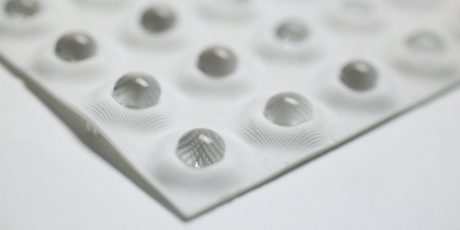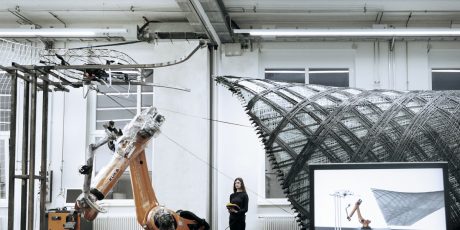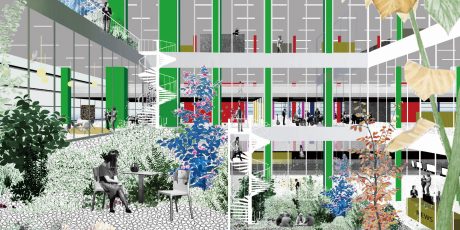Interviews Excerpt From “An Interview With the Partners of DS+R: Democratizing Space”
The following text is an excerpt from an interview done with the studio’s partners—Elizabeth Diller, Ricardo Scofidio, Charles Renfro, and Benjamin Gilmartin—for our June 2019 issue, a+u Diller Scofidio + Renfro.

Democratizing Space
a+u: You’ve stated that two common threads in your work are the democratization of art and the designing of spaces for the public. Can you expand on that?
Elizabeth Diller (Liz): When Ric and I started, we were working during a time of institutional critique that questioned what could be defined as a space for art. Is it in the museum? Is it in the street? We did a lot of our early independent work on found, borrowed sites. Sometimes we squatted as a form of guerrilla architecture. It was often ephemeral – at times only in existence for 24 hours.
So the idea of working in the public realm was always part of the ethos of our work. At a time when our cities are being rapidly privatized, it’s also important to protect the decreasing publicness of our cities and defend the importance of parks and public spaces. It’s really important for architects to advocate the democratization of space for its health, recreational and social value. That drove our work on the High Line and at Lincoln Center, where we felt it was important to extend the openness and accessibility of the public realm into institutional space just beyond the walls and to infuse both with cultural offerings. There should be spaces you can enjoy with or without a ticket.
Ricardo Scofidio (Ric): It’s interesting because when I was a student studying architecture, public space was external, exterior, and it stopped at the door. Public space never entered the door into lobbies or anywhere else. The moment you passed through the door, you were no longer in public space. And so there’s been an incredible transformation in the way we see buildings and how they function since then. I think we were very interested in exploring what the world meant if you looked at it through the eyes of an architect, whether it was public space, whether it was performance, whether it was built form, or unbuilt form. So I think we really expanded – for ourselves and the public in general –the definition of architecture.

Liz: In many of our projects, we claim more space than we actually have. There’s the possibility of extending your physical space with optical space and enabling us to look at the city in a different way. I think that’s what’s really strong and unusual about the High Line, and one of the reasons it became so popular. It opened up more than the surface of the High Line. It opened up new, unofficial vistas of New York. You can sit on the sunken overlook on 10th Avenue, looking at traffic going into the vanishing point. It was a technique of controlling a view optically, which I think may be common in Japanese landscape design as well. We think of that very much as a way of extending our ability to appreciate deep space even if it isn’t technically part of the site.
Ric: I think also that for years, it spoke to an understanding of Manhattan as a map. Where you were, you would always think of yourself in relation to an intersection on a map. And I think the High Line was one of the first times you really could look at the space of the city optically, and understand where you were visually rather than thinking about it mentally as a map condition. I think that was very important for people, because in a way it goes back to kind of the history of architecture, of the piazza, the plaza, the experience of understanding your location within an urban condition, by being able to visually see where you are, rather than to only think about where you are.
Benjamin Gilmartin: I also think it’s ultimately all about the social life of the city and trying to foster as much energy and interaction as possible so that a critical mass of people is attracted to that social life. That can happen through formal cultural programming, but oftentimes it’s also a result of the very informal spaces that we make, where people are passing through and they end up sticking there and hanging out.

Charles Renfro: Democratizing space is definitely one of the calling cards of our practice. We aim to make each project more generous and more engaged with the broader public than the client ever anticipated it could be. From the High Line to Zaryadye Park in Moscow, our work is defined by free and accessible space. Each offers a new generosity to a shared experience. Tickets are not required. Informality is encouraged in lieu of predetermined experiences. Access is granted to everyone regardless of race or class or gender or sexuality or education level or nationality. Fences and gates were originally required at Zaryadye Park, but we insisted on openness and 24/7 accessibility. We were able to convince the client to allow the park to be completely porous to various points of entry around the city.
Another project that I hope will radically revolutionize this principle is the Museum of Image and Sound, which is yet to open in Rio de Janeiro. Even without a ticket, visitors can access the building directly from Burle Marx’s iconic promenade, walk up the exterior stair of the building, look into the galleries, and enjoy the public rooftop. This will be the first elevated vantage point of the beach that doesn’t require you to own a private residence or be a guest at a fancy beachside hotel. Museums are typically not considered places of democracy but places for the elite. We wanted to flip that script by having the Rio project be an extension of Copacabana Beach, one of the most democratic spaces in Rio.
Liz: With the expansion of the Museum of Modern Art (MoMA), which we will be finishing this October, we are democratizing the entire ground floor at the street level. One of our main critiques of MoMA’s previous iterations was that art was half a mile away from the entrance. You have to walk in, through, up, into galleries, to actually see anything. We wanted to bring art closer to the street, so now there will be several galleries that are on the ground floor, free and open to the public.
We are submerging the commercial store that once blocked MoMA’s frontage in an open, double-height space. There’s now a two-way visual connection between the lobby and the street for the public. It’s quite transparent. And we’re removing those big ticketing queues from the entrance and relocating ticketing away from the front door to an adjacent space that’s slightly elevated. The curators will have more freedom to use the street-level space for art. The garden is still free and open as it always was.
The Shed was conceived programmatically and physically as radically open to the public, exposing new populations to experimental work in the arts that would otherwise not be exposed to it. The shell nests onto the fixed building, exposing an open public space. For performances, there are ten dollar tickets in every row, rather than just in the nosebleed area. The Shed features emerging artists along with established ones.






